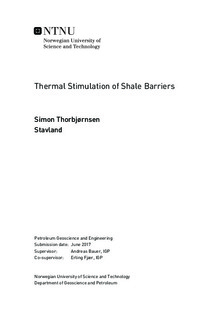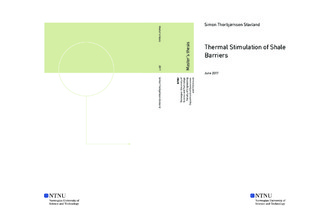| dc.description.abstract | Some shale sections in petroleum wells have shown to form effective annular barriers with the casing due to creep. These barriers are now acknowledged by the petroleum safety authority of Norway as verified well barrier elements for permanent plug and abandonment. Stimulation of such barriers in areas where shale barriers have not been formed is key to significant cost reduction in offshore plug and abandonment operations. The purpose of this thesis is to investigate whether thermal stimulation of shale barriers can induce sufficient plastic deformation to form a barrier. Failure criteria, plasticity and thermoelasticity related to rocks have been evaluated to understand governing concepts related to this stimulation technique. A coupled temperature-pore pressure finite element analysis was used to study a shale formation in hollow cylinder geometry subject to four days of heating on the borehole wall. Furthermore, a sensitivity analysis with respect to stress conditions and rock and fluid properties was conducted.
The results showed significant displacement into the borehole and plastic strain developing deeper into the formation than the initial stress redistribution. This indicates that heating is a more effective stimulation technique than reducing well pressure. Heating associated pore pressure increase was more important than earth stress increase, resulting in lower effective stress and stress conditions shifting towards the failure envelope. Furthermore, simulation of temperature reduction after heating showed that the established shale deformation due to heating does not recede when temperature reduces to its in-situ state.
Strong stress concentration around the borehole and a lower dilatancy angle were found to be the most important conditions to improve the potential for obtaining a sealing barrier. Hence, a combination of well pressure reduction and thermal stimulation is suggested as a more effective stimulation technique. Moreover, a higher thermal expansion coefficient of the matrix may cause more displacement into the borehole, but is believed to have a limited effect. Permeability in the nano-darcy range is essential for pore pressure accumulation, and a permeability lower than this did not show any significant effects on the displacement of the borehole wall. Stress anisotropy resulted in varying displacement around the borehole, and in general, there was more displacement in the direction of minimum horizontal stress.
The results of the finite element analysis show that heating induced shale barriers is a promising stimulation technique, but further development of simulations, laboratory experiments, and field tests are required to verify its feasibility. | |

